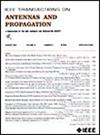Solving the Efficiency-Dip Problem of Adding Parasitic Elements for Ultrathin Microstrip Antennas
IF 5.8
1区 计算机科学
Q1 ENGINEERING, ELECTRICAL & ELECTRONIC
引用次数: 0
Abstract
As a common technique to broaden the bandwidth of ultrathin microstrip antennas, adding the parasitic elements often encounters the problem of efficiency dip. This phenomenon is due to the radiation cancellation caused by the out-of-phase currents between the parasitic element and the main radiator. This article proposes a solution by introducing another parasitic element near the initial one and enabling them to resonate in differential mode (DM), and the radiation cancellation at the efficiency dip can be significantly mitigated without attenuating bandwidth expansion. To illustrate this method, an ultrathin dual-polarized microstrip antenna is presented as an example. By designing a pair of L-shaped parasitic strips and converting the parasitic mode from common mode (CM) to DM, the in-band gain variation is reduced from 5.8 to 1.9 dB. The measured results show that the antenna operates with an impedance bandwidth of 2.3% in an extremely low profile of解决超薄微带天线中增加寄生元件的效率下降问题
作为超薄微带天线常用的增宽技术,增加寄生元件往往会遇到效率下降的问题。这种现象是由于寄生元件与主散热器之间的异相电流造成的辐射抵消。本文提出了一种解决方案,通过在初始寄生元件附近引入另一个寄生元件,使它们在差分模式(DM)下共振,从而在不衰减带宽扩展的情况下显著减轻效率下降时的辐射抵消。以超薄双极化微带天线为例说明了该方法。通过设计一对l型寄生带,并将寄生模式从共模转换为DM,将带内增益变化从5.8 dB减小到1.9 dB。测量结果表明,该天线在$0.008~\lambda _{L}$ ($\lambda _{L}$为7.9 GHz自由空间波长)的极低轮廓下工作,阻抗带宽为2.3%。该方法有效地缓解了寄生元件带来的效率下降,为超薄微带天线的带宽扩展提供了一种可行的解决方案。
本文章由计算机程序翻译,如有差异,请以英文原文为准。
求助全文
约1分钟内获得全文
求助全文
来源期刊
CiteScore
10.40
自引率
28.10%
发文量
968
审稿时长
4.7 months
期刊介绍:
IEEE Transactions on Antennas and Propagation includes theoretical and experimental advances in antennas, including design and development, and in the propagation of electromagnetic waves, including scattering, diffraction, and interaction with continuous media; and applications pertaining to antennas and propagation, such as remote sensing, applied optics, and millimeter and submillimeter wave techniques

 求助内容:
求助内容: 应助结果提醒方式:
应助结果提醒方式:


